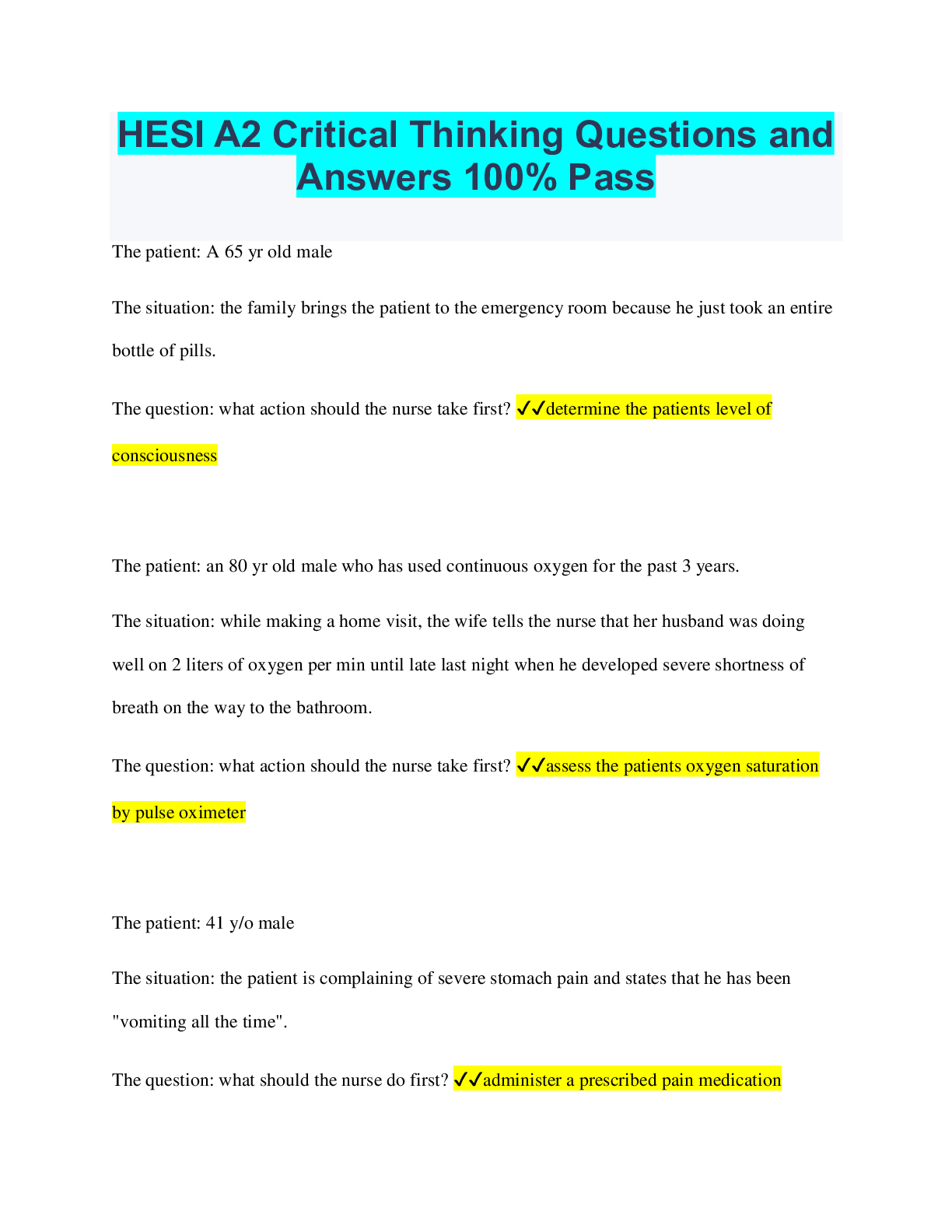Chemistry > QUESTIONS & ANSWERS > AQA A level Chemistry 3.1.8 – Thermodynamics Already Passed (All)
AQA A level Chemistry 3.1.8 – Thermodynamics Already Passed
Document Content and Description Below
AQA A level Chemistry 3.1.8 – Thermodynamics Already Passed What are standard conditions? ✔✔298K/25°C 100kPa/1 atm 1 moldm-3 Enthalpy change of formation ✔✔The enthalpy change when 1 m... ole of a compound is formed from its constituent elements under standard conditions, with all reactants and products in their standard states. Enthalpy change of combustion ✔✔The enthalpy change when 1 mole of a substance is burned completely in oxygen. Enthalpy change of atomisation ✔✔The enthalpy change that accompanies the formation of 1 mole of gaseous atoms from the element in its standard state. First ionisation enthalpy ✔✔The enthalpy change when 1 mole of gaseous atoms loses 1 electron per atom to form 1 mole of gaseous 1+ ions. Second ionisation enthalpy ✔✔The enthalpy change when 1 mole of gaseous 1+ ions loses 1 electron per atom to form 1 mole of gaseous 2+ ions. First electron affinity ✔✔The enthalpy change when 1 mole gaseous atoms gains 1 electron per atom to form 1 mole of gaseous 1- ions. Second electron affinity ✔✔The enthalpy change when 1 mole of gaseous 1- ions gains 1 electron per atom to form 1 mole of gaseous 2- ions. Mean bond enthalpy ✔✔The enthalpy change when 1 mole of gaseous molecules each breaks a covalent bond to form 2 gaseous ions or free radicals. Lattice enthalpy of formation ✔✔The enthalpy change when 1 mole of a solid ionic compound is formed from its gaseous ions. Lattice enthalpy of dissociation ✔✔The enthalpy change when 1 mole of a solid ionic compound dissociates into its gaseous ions. Enthalpy of hydration ✔✔The enthalpy change when 1 mole of gaseous ions dissolves completely in water. Enthalpy of solution ✔✔The enthalpy change when 1 mole of an ionic solid dissolves in enough solvent to ensure that the dissolved ions are well separated and do not interact with one another. Enthalpy of vaporisation ✔✔The enthalpy change when 1 mole of a liquid evaporates to form 1 mole of a gas. Enthalpy of sublimation ✔✔The enthalpy change when 1 mole of a solid sublimes to form 1 mole of a gas. Why are ionisation enthalpies always positive (endothermic)? ✔✔Energy needs to be put in to pull an electron away from the nucleus to overcome the electrostatic attraction. Why are first electron affinities always negative (exothermic)? ✔✔Energy is given out when an electron is attracted to the positively charged nucleus. Why are second electron affinities and onwards always positive (endothermic)? ✔✔Energy needs to be put in to overcome the repulsion between an electron and a negatively charged ion. As the charge of ions increases, the lattice enthalpy... ✔✔Increases. As the ionic radius increases, the lattice enthalpy... ✔✔Decreases. If there is "good agreement" between the experimental value (Born-Haber Cycle) and the electrostatic attraction theory (Perfect Ion Theory) then the bonding is... ✔✔Pure ionic bonding. If there is "significant difference" between the experimental value (Born-Haber Cycle) and the electrostatic attraction theory (Perfect Ion Theory) then the bonding is... ✔✔Ionic bonding with some covalent character. How much is a significant difference in the perfect ion theory? ✔✔Over 7%. As charge of CATION (+) increases, covalent character... ✔✔Increases. As ionic radius of CATION (+) increases, covalent character... ✔✔Decreases. As charge of ANION (-) increases, covalent character... ✔✔Increases. As ionic radius of ANION (+) increases, covalent character... ✔✔Increases. What is the symbol for entropy and what is it measured in? ✔✔S JK⁻¹mol⁻¹ When the number of molecules increases, entropy... ✔✔Increases. When the temperature increases, entropy... ✔✔Increases. Exothermic reactions are _________ likely to happen. ✔✔More Endothermic reactions are _________ likely to happen. ✔✔Less Why are exothermic reactions more likely to happen, and endothermic reactions less likely to happen? ✔✔The universe favours lower enthalpies, so reactions that result in a lower enthalpy are favoured over reactions that result in a higher enthalpy. What is the symbol for Gibb's free energy and what is it measured in? ✔✔G kKmol-1 If a process has ΔG ≤0 then it is... ✔✔Feasible. If a process has ΔG >0 then it is... ✔✔Not feasible. Gibb's free energy equation ✔✔ΔG = ΔH - T x ΔS ΔS must ÷ 1000 to be in kJK⁻¹mol⁻¹ An ENDOthermic reaction with an INCREASE in entropy is... ✔✔Feasible ABOVE a critical temperature. An ENDOthermic reaction with an DECREASE in entropy is... ✔✔Never feasible. An EXOthermic reaction with an INCREASE in entropy is... ✔✔Always feasible. An EXOthermic reaction with an DECREASE in entropy is... ✔✔Feasible BELOW a critical temperature. At 0K the Gibb's free energy equation is ✔✔ΔG = ΔH At the critical temperature, the Gibb's free energy equation is ✔✔Tc = ΔH ΔS [Show More]
Last updated: 2 years ago
Preview 1 out of 7 pages

Buy this document to get the full access instantly
Instant Download Access after purchase
Buy NowInstant download
We Accept:

Also available in bundle (1)

AQA A LEVEL Chemistry Bundled Exams Questions and Answers 100% Pass
AQA A LEVEL Chemistry Bundled Exams Questions and Answers 100% Pass
By Nutmegs 2 years ago
$22
13
Reviews( 0 )
$10.00
Can't find what you want? Try our AI powered Search
Document information
Connected school, study & course
About the document
Uploaded On
May 07, 2023
Number of pages
7
Written in
Additional information
This document has been written for:
Uploaded
May 07, 2023
Downloads
0
Views
135














